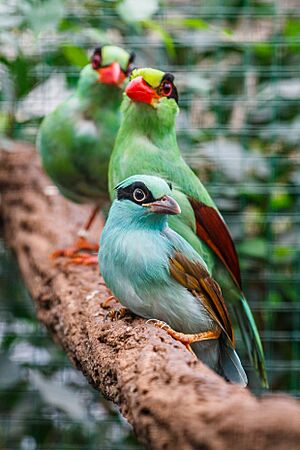Javan green magpie facts for kids
Quick facts for kids Javan green magpie |
|
|---|---|
 |
|
| Individual at Chester Zoo | |
| Conservation status | |
| Scientific classification | |
| Genus: |
Cissa
|
| Species: |
thalassina
|
The Javan green magpie (Cissa thalassina) is a passerine bird in the crow family, Corvidae. This critically endangered species is endemic to montane forests on the Indonesian island of Java. It formerly included the Bornean green magpie as a subspecies, in which case the "combined" species was known as the short-tailed magpie.
Once common, the species has declined drastically as a result of habitat loss and illegal capture for the wild animal trade. The size of the remaining wild population is unknown, but perhaps only around 50 individuals, while others speculate that the lack of recent sightings might mean that it already is extinct in the wild.
In an attempt at saving the species, a captive breeding program based on confiscated individuals has been initiated by the Cikananga Wildlife Center in Java (since 2011) and a few European EAZA zoos (since 2015). It has successfully bred at both the Javan and European facilities, and as of 2018 this captive population had reached about 50 individuals.
Appearance
Javan green magpies are primarily a vivid green, with a black "mask" marking around their eyes, russet wings, and white tertiary feathers. They have bright red beaks and eyerings; their legs are equally bright, ranging from red to orange. Their eyes are dark brown and they have a relatively short tail.
The bright green plumage is the result of a combination of structural coloration, and the yellow pigment lutein, which they gain from their insect diet. They also feed on small lizards and frogs.
In captivity, adults turn bluish (the structural colour of their feathers) if their diet is inadequate in lutein.
Young
Javan green magpies lay cream coloured speckled eggs and are altricial, hatching with no feathers, completely dependant on their parents. A fledgeling's initial plumage is bluish, with the dark face and wing markings. They have beige-brown beaks and eyerings with light orange legs. After their first moult they become green.



